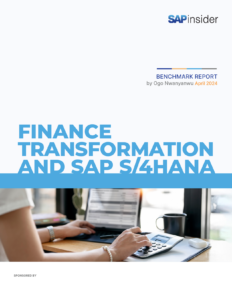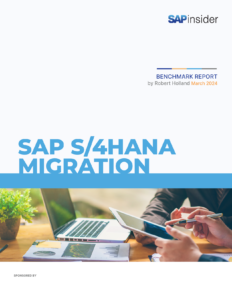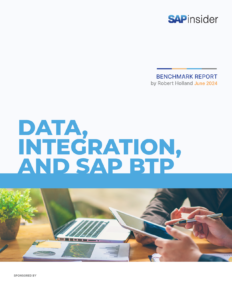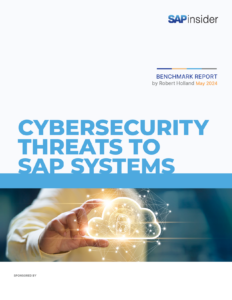SAPinsider 2024 Research Agenda
Financial Management | ERP, Platform & Cybersecurity | Application Development & Integration Security | Analytics & AI |Our Methodology
Financial Management
 Finance Process Automation – February 2024
Finance Process Automation – February 2024 
 Finance Transformation and SAP S/4HANA – April 2024
Finance Transformation and SAP S/4HANA – April 2024 
 Global Tax Management – June 2024
Global Tax Management – June 2024 
 Cash Management and Cash Visibility – August 2024
Cash Management and Cash Visibility – August 2024 
 Financial Close and Record-to-Report – September 2024
Financial Close and Record-to-Report – September 2024 
 Tax Technology Innovation and Automation – December 2024
Tax Technology Innovation and Automation – December 2024 
ERP, Platform & Cybersecurity
 SAP Infrastructure and Landscape Trends – February 2024
SAP Infrastructure and Landscape Trends – February 2024 
SAP workloads continue to move to the cloud at an accelerating pace. Related to this move a significant proportion of SAP organizations have indicated that they are planning on updating the infrastructure on which their SAP landscape is running. This report will examine the infrastructure and landscape trends during 2023 and into 2024. Are organizations moving more workloads to the public cloud? Are they staying with their usual hosting partners? How much are operational expenditure based internal landscapes being adopted? How is SAP’s focus on RISE with SAP impacting the traditional on-premise landscape that has been the foundation of the organization’s success over the last 30 years? And what role is sustainability playing in these plans?
 SAP S/4HANA Migration – March 2024
SAP S/4HANA Migration – March 2024
Around a third of SAP’s existing enterprise ERP base has now licensed SAP S/4HANA, though many are still undecided about what their plans will be. Most existing customers are concerned about the complexity of the move and have a desire to remain with perpetual licenses, but SAP is pushing their cloud ERP strategy that focuses on RISE with SAP and SAP S/4HANA Cloud. This report will examine the adoption trends for SAP S/4HANA over the last five years, the version of the solution that organizations are deploying, the challenges that they are encountering with the move, as well as the benefits that those whthat have already moved to SAP S/4HANA are experiencing.
 Data, Integration, and SAP BTP – June 2024
Data, Integration, and SAP BTP – June 2024 
Few SAP organizations today are running homogeneous SAP environments with most running a combination of SAP and non-SAP systems across their enterprise. This creates challenges from a data and integration perspective, especially for business users that are demanding data from multiple sources in their analytics applications and that have workflows that span multiple applications both in the cloud and on-premise. IT departments are deploying technologies that will help enable seamless integration and harmonization, while SAP has released SAP Datasphere to maintaining the context and logic of that data. But this is only one solution in play in the data and integration space. This research will explore the drivers, actions, requirements, and technologies around data and integration in this more connected SAP world.
 Deployment Approaches for SAP S/4HANA – July 2024
Deployment Approaches for SAP S/4HANA – July 2024
 Enterprise Cloud – September 2024
Enterprise Cloud – September 2024
 RISE with SAP – November 2024
RISE with SAP – November 2024
Security
 Cybersecurity Threats and Challenges for SAP Systems – May 2024
Cybersecurity Threats and Challenges for SAP Systems – May 2024 
For the last two years ransomware and malware attacks were identified as the two biggest threats for SAP systems. But the biggest challenge in securing SAP systems is unpatched systems. With the ever-increasing frequency of cyberattacks, keeping systems up to date is crucial to preventing cyberattacks and keeping systems available. 2023 also saw increased adoption of technologies that provided information about new threats or helped reveal attacks in progress. This research will explore the year over year trends in the cybersecurity space, what organizations perceive as the biggest threats to their systems, the challenges they face addressing those threats, and examining trends over the last three years of similar research.
 SAP Cybersecurity Priorities – October 2024
SAP Cybersecurity Priorities – October 2024
Application Development & Integration
 SAP Data Management/Strategies and SAP HANA- April 2024
SAP Data Management/Strategies and SAP HANA- April 2024
Many organizations are now leveraging SAP HANA either with another SAP application or as a data lake within their organization. But with this move SAP customers must plan for how to manage, maintain and utilize SAP data for analytics and automation. how to handle legacy data, especially for greenfield SAP S/4HANA projects, and how to manage data on the cloud. Balancing the risks, compliance needs, and costs of data management in multiple venues including the cloud while also providing reliable, secure data to the organization is increasingly important to the business. This research will examine the approaches and the technologies SAP customers are taking for where to host data and the factors driving the decisions.
Analytics and AI
 Process Automation and SAP S/4HANA – April 2024
Process Automation and SAP S/4HANA – April 2024
SAPinsiders have consistently indicated that leveraging process automation and process Intelligence platforms will enable them to digitalize, discover, understand, and manage business process execution more effectively. While many of them may already have built a foundation in terms of process automation, process Intelligence capability will allow them to leverage advanced algorithms to model specific events across their processes, visualize these to identify deviations, find process bottlenecks and perform root cause analysis of process failures. SAPinsiders will increasingly invest in building these capabilities in the next two years
About the SAPinsider DART Methodology
SAPinsider has rewritten the rules of research to provide demonstrable insights from its fact-based approach. The DART methodology serves as the very foundation on which SAPinsider educates end users to act, creates market awareness, drives demand, empowers sales forces, and validates return on investments. It’s no wonder that organizations worldwide turn to SAPinsider for research with results. The DART methodology provides actionable insights including:
- Drivers – These are macro level events that are impacting an organization. They can be both external and internal and require the implementation of strategic plans, people, processes and systems.
- Actions – These are strategies that companies can implement to address the drivers impact on the business. These are the integration of people, process and technology. The should be business first but fully leverage technology enabled solutions to be relevant for our focus.
- Requirements – These are business and process level requirements to support the strategies. These tend to be end-to-end for a business process.
- Technology – There are technology and systems related requirements that enable the business requirements and support the overall strategies that the company is taking, they must consider the current technology architecture and provide for the adoption of new and innovative technology enabled capabilities
How SAPinsiders Participate in the Research
The SAPinsider research process is an invitation-only quantitative survey and a qualitative interview-based methodology that is focused on the voice of the more than 600,000+ global SAPinsider community members. During the course of a year, we survey and interview several thousand SAPinsiders and synthesize their insights. This peer best practices-led benchmarking research process extracts intricate knowledge of SAP and related ecosystem solutions, migration paths, roadmap and other insights in relation to the business drivers, strategic actions and requirements of end users. The ultimate objective of our research is to enable SAP users adopt and upgrade technology efficiently, based on sound decisions, performance parameters and business value.